If ever in a situation where you are lost or stranded in the woods or when SHTF, then you will be looking for alternative food sources. There are several things around you that you can eat, but you may have never considered. Wild plants are one such example. These can provide you with the needed nutrients and such, to keep you and your family from starving.
When foraging for these wild edibles it is important to remember that some of these plants will require some basic work before consuming, such as stripping down roots to get to the starchy substance in the middle, or even some grinding of some plant parts before consumption.
#1. Ramps
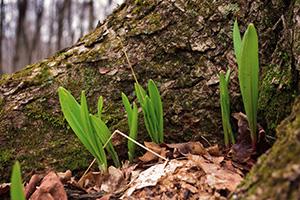
Ramps can be foraged for in the spring. They are kind of a mix between onion and garlic in flavor. The roots grow just below the soil and they grow in patches together.
When digging ramps, it is ideal to conserve the patch by cutting off the root ball with a sharp knife and taking the plant only; this is so you can come back to the same patch next spring. Every part of the ramp is edible and can be eaten raw or used in recipes.
#2. Clover
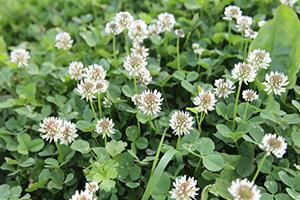 There are different types of clover that grow in your yard, such as red clover and white clover. This is distinctive based on the color of the flower. Simple really. And not just livestock or wild rabbits can eat clover. The whole plant is edible and is best eaten while fresh or completely dried out.
There are different types of clover that grow in your yard, such as red clover and white clover. This is distinctive based on the color of the flower. Simple really. And not just livestock or wild rabbits can eat clover. The whole plant is edible and is best eaten while fresh or completely dried out.
Clover is very healthy for you as it helps ward off colds, reduce respiratory problems, and it is even said that it can purify blood and help ward off cancer. You can grind the leaves to make flour, but it’s a long process. The flower is the best part to eat. When preserving, you can dry the plant and flower head separately. Use a dehydrator, screen in a drying room, or very low temperatures in the oven. Once the plant is dried, you can store it in jars for use over the winter too.
#3. Purslane
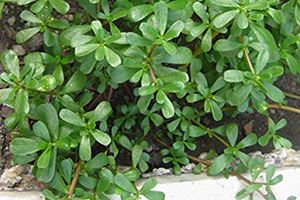 Purslane is identified by the smooth reddish stems and leaves, that are opposite of each other. The flower is yellow with five regular parts and it opens any time of the year at the center of the leaf cluster. Purslane is a ground cover and has a deep root system. The stem, leaves, and flower buds are edible. You can eat it raw in a salad, use in a stir fry, or cooked in soups and other recipes. Purslane has a slightly sour taste. Raw purslane is 93% water.
Purslane is identified by the smooth reddish stems and leaves, that are opposite of each other. The flower is yellow with five regular parts and it opens any time of the year at the center of the leaf cluster. Purslane is a ground cover and has a deep root system. The stem, leaves, and flower buds are edible. You can eat it raw in a salad, use in a stir fry, or cooked in soups and other recipes. Purslane has a slightly sour taste. Raw purslane is 93% water.
Related: 79 Edible Flowers in North America (with Pictures)
#4. Daisies
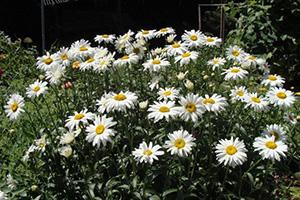 The daisy is a childhood favorite of mine. I used to pick it for my mom and grandmas. I didn’t know you could eat them back then. The flower petals can be used as a garnish or in salads, and the leaves can be used on sandwiches or in salads. It is not recommended that you eat the yellow center of the daisy, as this is the pollen section of the flower.
The daisy is a childhood favorite of mine. I used to pick it for my mom and grandmas. I didn’t know you could eat them back then. The flower petals can be used as a garnish or in salads, and the leaves can be used on sandwiches or in salads. It is not recommended that you eat the yellow center of the daisy, as this is the pollen section of the flower.
#5. Cattails
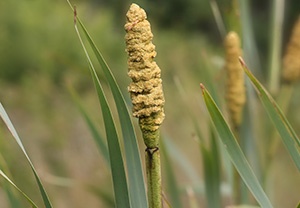 If you have seen a body of water you have probably seen a cattail. The lower leaves can be used in salads, while the stem can be eaten raw or boiled. The cattail itself (the brown cigar shape at the top) can be roasted.
If you have seen a body of water you have probably seen a cattail. The lower leaves can be used in salads, while the stem can be eaten raw or boiled. The cattail itself (the brown cigar shape at the top) can be roasted.
The yellow pollen that appears in midsummer can used as a thickener, and in bread and pancake mixes. The roots contain a lot of starches and can be dried and then pounded into flour, or you can strip it off and chew on it to get the starches and then spit out the tough part. Here are 10 delicious recipes you can make using cattails.
#6. Lamb’s Quarters
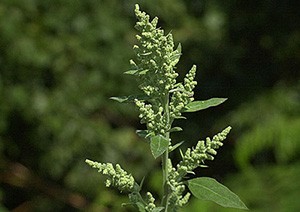 This wild edible looks dusty from a distance due to the white coating on the leaves. The plant produces little green flowers that are grouped together in clusters on the stem and upper branches. When eating lamb’s quarter, you can consume the leaves, shoots, seeds, and flowers. This plant does contain oxalic acid, but when cooked the acid goes away. You can blanch and freeze the leaves for later use. Lamb’s quarter is also good for salads and soups. It can also be sautéed or steamed, as well as a valuable addition to smoothies and juices.
This wild edible looks dusty from a distance due to the white coating on the leaves. The plant produces little green flowers that are grouped together in clusters on the stem and upper branches. When eating lamb’s quarter, you can consume the leaves, shoots, seeds, and flowers. This plant does contain oxalic acid, but when cooked the acid goes away. You can blanch and freeze the leaves for later use. Lamb’s quarter is also good for salads and soups. It can also be sautéed or steamed, as well as a valuable addition to smoothies and juices.
#7. Milk Thistle
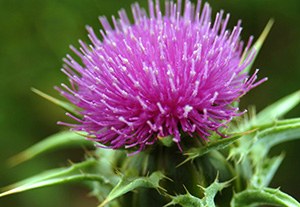 Milk Thistle is good for medicinal purposes but also for eating. You can eat the leaves and flowers as vegetables in a salad. The seeds can also be roasted and used as a coffee substitute, or dried to eat as a snack. The plant has large bright purple flowers, and the leaves have white markings. When broken, a milky sap comes out.
Milk Thistle is good for medicinal purposes but also for eating. You can eat the leaves and flowers as vegetables in a salad. The seeds can also be roasted and used as a coffee substitute, or dried to eat as a snack. The plant has large bright purple flowers, and the leaves have white markings. When broken, a milky sap comes out.
#8. Wild Asparagus
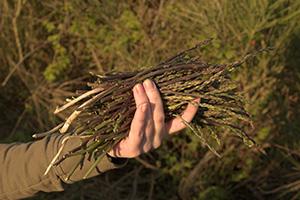 Wild asparagus is edible. It is basically a plant that got transplanted from a seed head which traveled, and from there it started growing in the wild. You will find it along roads and in fields.
Wild asparagus is edible. It is basically a plant that got transplanted from a seed head which traveled, and from there it started growing in the wild. You will find it along roads and in fields.
Look for the asparagus in the late spring to harvest it. If it gets too big, it is going to seed again. And you can return the next spring for a new harvest. Prepare the wild asparagus grilled or baked and seasoned. To store any extra wild asparagus, you can blanch it and freeze it, or seal in vacuum bags.
#9. Goldenrod
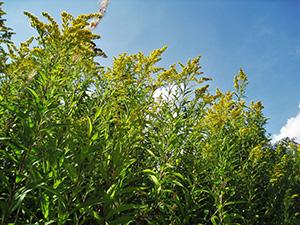 This plant can grow from 24 to 30 inches in height. It is topped with golden flowers that grow in clusters. The leaves taper to a point and have small teeth on the edge. The bottom of the leaf is kind of hairy and rough on the top, with three veins that run parallel along the length of the leaf. Goldenrod can be preserved in about any form, from drying to pickling. Dried flowers and leaves can be added to any meal for a nice flavor. They can also be used for tea. The roots can be harvested when young and dried, and used for soups and batter mixes. Leaves and flowers can be used in salads and soups. The stalk is tough but edible, especially if harvested young. It can be baked in the oven and made into a crispy snack.
This plant can grow from 24 to 30 inches in height. It is topped with golden flowers that grow in clusters. The leaves taper to a point and have small teeth on the edge. The bottom of the leaf is kind of hairy and rough on the top, with three veins that run parallel along the length of the leaf. Goldenrod can be preserved in about any form, from drying to pickling. Dried flowers and leaves can be added to any meal for a nice flavor. They can also be used for tea. The roots can be harvested when young and dried, and used for soups and batter mixes. Leaves and flowers can be used in salads and soups. The stalk is tough but edible, especially if harvested young. It can be baked in the oven and made into a crispy snack.
Related: 20 Wild Plants That Can Save Your Life
#10. Chickweed
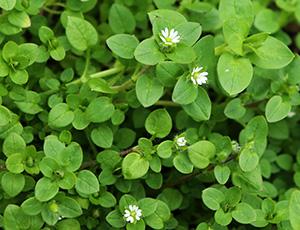 Chickweed is best eaten fresh, but you can also eat it raw. The stem, leaves, flowers, and seed pods can be consumed. You can eat it raw in salads, or you can steam or sauté it. Simply take scissors and cut the amount that you desire.
Chickweed is best eaten fresh, but you can also eat it raw. The stem, leaves, flowers, and seed pods can be consumed. You can eat it raw in salads, or you can steam or sauté it. Simply take scissors and cut the amount that you desire.
Chickweed has little white flowers with five double lobes. The leaves are pointed and oval shaped. They grow in pairs across from each other. The leaves grow far apart on the length of the stem. There is a hairy type line that runs up the stem between the leaves.
#11. Stinging Nettles
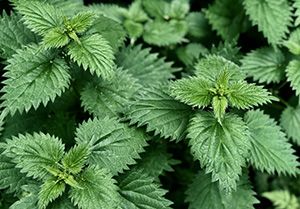 The stinging nettle gets its name by the fact that it has little hairs or spines that irritate your skin, and can even leave welts due to a toxin in them. It is recommended that you only pick the top five to six leaves from the plant, when it is young and before the flowers start to form. To prep the nettles, simply soak them in cold salted water and then drain and dry them. You can freeze them for later use or use them immediately. Stinging nettles can be used as a replacement for spinach, and once cooked they lose their stinging ability.
The stinging nettle gets its name by the fact that it has little hairs or spines that irritate your skin, and can even leave welts due to a toxin in them. It is recommended that you only pick the top five to six leaves from the plant, when it is young and before the flowers start to form. To prep the nettles, simply soak them in cold salted water and then drain and dry them. You can freeze them for later use or use them immediately. Stinging nettles can be used as a replacement for spinach, and once cooked they lose their stinging ability.
Related: How to Cook Spring Nettles
#12. Queen Anne’s Lace
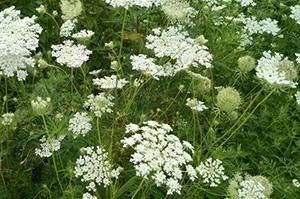 Queen Anne’s lace is also known as wild carrots. This plant has a large flat white flower, with a red or dark center. The stalk is hairy and the root resembles a carrot. It is best to eat the root in the first year, as in the second year it becomes more tough. The green tops are also edible, as you can boil them in soups and stews, or as greenery to dishes. If the stem is not fuzzy or hairy, then it is not Queen Anne’s lace and could be poisonous.
Queen Anne’s lace is also known as wild carrots. This plant has a large flat white flower, with a red or dark center. The stalk is hairy and the root resembles a carrot. It is best to eat the root in the first year, as in the second year it becomes more tough. The green tops are also edible, as you can boil them in soups and stews, or as greenery to dishes. If the stem is not fuzzy or hairy, then it is not Queen Anne’s lace and could be poisonous.
#13. Sorrel
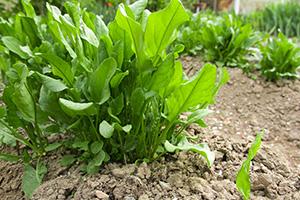 Sorrel is a plant that consists of leafy greens. It has an intense lemony flavor, that becomes more bitter as the leaves age and grow. The smaller leaves can be eaten raw in salads or on sandwiches. The larger leaves should be cooked to help get rid of the bitterness. There are three types of sorrel: red veined, broad leaf, and french. The red veined is self-explanatory, with a slender tapered leaf with red veins throughout it. The broad leaf has slender arrow shaped leaves. The french sorrel has small bell-shaped leaves.
Sorrel is a plant that consists of leafy greens. It has an intense lemony flavor, that becomes more bitter as the leaves age and grow. The smaller leaves can be eaten raw in salads or on sandwiches. The larger leaves should be cooked to help get rid of the bitterness. There are three types of sorrel: red veined, broad leaf, and french. The red veined is self-explanatory, with a slender tapered leaf with red veins throughout it. The broad leaf has slender arrow shaped leaves. The french sorrel has small bell-shaped leaves.
#14. Watercress
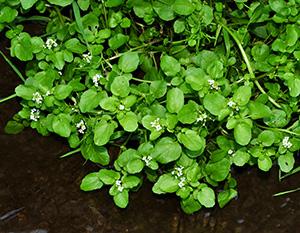 Watercress has a peppery green flavor that goes great with other neutral greens. It can be found all year round in the stores, but it is best in the spring. It is a water grown leafy vegetable, hence the name. If watercress becomes wilted, simply shake it back with cold water, or wrap it in a damp paper towel and place it in a plastic bag.
Watercress has a peppery green flavor that goes great with other neutral greens. It can be found all year round in the stores, but it is best in the spring. It is a water grown leafy vegetable, hence the name. If watercress becomes wilted, simply shake it back with cold water, or wrap it in a damp paper towel and place it in a plastic bag.
You can use watercress by washing it and patting it dry, and then use it raw on sandwiches or in salads, sautéed or steamed.
#15. Berries
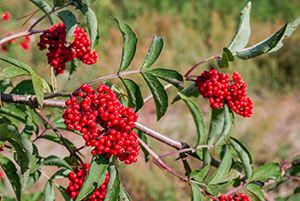 We all have picked blackberries and raspberries, but there are other berries growing in your backyard that are perfectly safe and healthy to eat. Elderberries are ready for harvest in the fall. They grow on shrubs and are a purple to black berry that grows in clusters.
We all have picked blackberries and raspberries, but there are other berries growing in your backyard that are perfectly safe and healthy to eat. Elderberries are ready for harvest in the fall. They grow on shrubs and are a purple to black berry that grows in clusters.
The elderberries must be ripe before consuming, and need to be cooked. This is what kills the astringent poison that they hold. Elderberries are great in syrups, wines, and in cobblers, pies and puddings.
There are many other plants and wild edibles that you can forage for. I am sure most preppers can name at least two others that are not here. What other edibles can you name?
You may also like:
The 5 Most C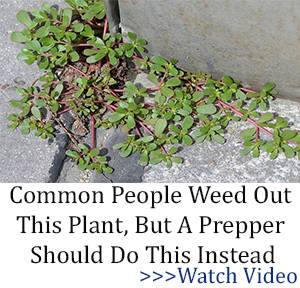 ommon Edible Weeds In Your State
ommon Edible Weeds In Your State
An Insanely Effective Way to Build a 5 Year Food Stockpile (Video)
What Plants Cowboys Ate in the West
Plants You Should Grow Around Your House To Repel Insects And Bugs (Including Termites)

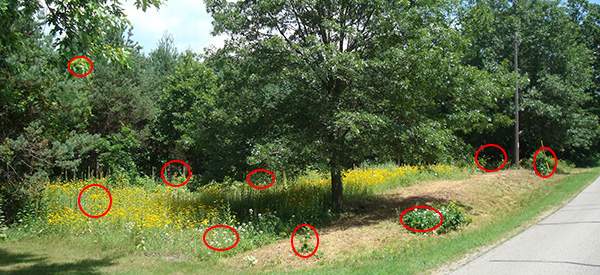













Yea I knew sorrel was edible since July 15 1954 because that is when seven brides for seven brothers was released and at the beginning of the movie after the Adam Pottipie got married his new bride got off the wagon and picked sorrel. And when they got to the house she met al his brothers and realized she should have picked more. So yea I knew this one. Sorry for being so dorky, I have been watching The Office episodes for three hours now.
I also remember that movie every time I see sorrell!!!?
How about Poke Salad? & The purple berries on it??
Pokeweed needs a mild caution–some people don’t tolerate poke at all, others have no problem. Be *sure* you have positively ID’d the spring shoots, and only the early shoots should be used. Eat just a little at first until you see how you tolerate it. The berries have a reputation for being poisonous–but it’s actually the seeds. Either dry the berries and take 1-2/day (old joint remedy–and the seeds will go straight through!) or cook, strain out the juice, and make jelly or syrup. I have not tried it, but the roots have also been made into a tincture and used as a remedy for (I believe) flu-like symptoms and malaise–but I do remember that the advice was to take only a few drops of the tincture, increase only a drop at a time, and back off if any dizziness occurs.
Do you have any suggestions as to wild edibles that can be found in desert areas?? We live in the high desert of Central Oregon and it’s pretty dry and not much “wild” grows around here.
Wild asparagus grows where you are. Also you have all that wild thyme for flavour and medicinal use. How about the wild rose hips and I have see wild gooseberry around the old mining sites. Mullien too for sore throats and bronchial problems.
Do you have mesquite? Honey mesquite will grow from Mexico’s deserts to Alberta and east to Louisiana. The pods are tasty (like carmel), the flower and green beans are good. Wood is cut and come again, and as a legume, it shades the garden in the summer, and produces a lot of nitrogen. You can pick up desert seeds from JLHudson seedsman for edible lilies, wild onions, and more that will grow in your zone.
I get that you are trying to set up a reason to know these plants, but it takes more study to learn most of these. In the situation above I wondered why the person had no seeds or had not previously planted some perennials. This would be the best way to prep for that scenario. Start a garden, even if its small and save seeds.
Yes….people must study ! Wild/wood violets are another food you can eat. Flowers/leaves. Not the stem.
what is the problem with the stem?
I have no idea. Articles that I read said not the stem. Perhaps that section of the plant is more toxic than the leaves/flower. https://thesurvivalmom.com/enjoy-wild-violets/ is one of many articles regarding wild violets. Cheers !
https://www.ediblewildfood.com/wild-violet.aspx
https://chestnutherbs.com/violets-edible-and-medicinal-uses/
http://foragedfoodie.blogspot.com/2017/03/foraging-for-wild-violets.html
I can’t find anything on toxic parts of violets. It doesn’t mean your source is wrong, but according to herbalists, anything above ground is eatable, cooked. I do know if you loose hogs in a pasture with violets, they root them out and you can forget foraging for them the next year. If it’s not toxic to pigs, we can eat it, but, it is better cooked.
Thanks for the links. Will check it out.. Cheers !
As a child we forraged violets. Just flowers and leaves. Mon would also gather mint. At the same time. She candied them. Such a delicate confection. They were especially pretty on a frosted cake or cupcakes. The candied mint was also wonderful. I’m not a big sweet eater but a candied flower or mint leaf was a special treat.
While this list is helpful, I would point out that unless one is very familiar with wild plants, danger lurks in harvesting plants that you are not absolutely familiar with.
For example poison hemlock strongly resembles Queen Anne’s lace.
Lamb’s quarter will ruin your liver if not prepared properly.
There is an onion-like plant that grows like an onion and looks like an onion but is also poisonous.
In addition a diet of just wild plants will do nothing to provide protein and fats. You still need to hunt or raise animals.
There are more caveats about wild plants but unfortunately, I am not enough of an expert to feel confident about listing them here.
Bottom line: Be very sure of what you are harvesting. Looking at pictures in a book may not be sufficient.
Queen Anne’s Lace vs. water hemlock is an easy one. Hemlock has a smooth stem, Queen Anne’s Lace has hairs. Queen Anne has hairy legs!
Most plant foods do awesome protein but it isn’t usually a complete protein unless you know what to combine with what. You do need some animal sources wether its eggs or flesh. Survival isn’t easy.
Here I grow what I’m able, gather what I know well enough to be confident of, and raise enough chickenss, ducks and rabbits for meat and eggs so we eat well. I can and dry to store food from season to season.
You should not eat too much of any Clover as it inhibits the bodies ability to absorb calcium
Regarding my above question: we DO have a big veggie garden, but I am curious as to what WILD plants are also edible – just in case we have a failure. Also, are there any good herbs for health/medicine that we can grow – since, basically, NOTHING grows wild around here!!!
Hi Maggie, I haven’t written much about wild edible plants in the desert (high desert of NW NV), but I have several articles on my blog about medicinal plants, including those found in our deserts. PrepSchoolDaily dot blogspot dot com. Juniper and Usnea are two of the most important ones. Oregon grape and Japanese barberry are up there, too.
You can also harvest/eat the flower and leaves of wild and/or wood violets! Do not eat the stem. The leaf grows on one stem and the flower on another stem. I have tons of this on my farm and have just studied the “violet” aspect of things. Some people complain as it can spread on to the grass. Out here, I don’t care. I absolutely love it when in garden beds or migrating to the lawn. Cheers !
What about Dandelions? My goodness, they are all over the place and are a wonderful and nutritious vegetable, not a useless weed. Early in the season they make a wonderful salad. Later they get a bit bitter. Than I boil them for three minutes, strain well than saute them in oil with garlic and eggs. Even the flowers can be used to make wine.
Yes, I do know about Dandelions, but even they don’t grow here and if they do, it’s very few!!
Maggie.
Desert areas are hard to forraged in yet natives of the area forraged and hunted to survive there.
I live in high mountain desert in New Mexico. Wild food isn’t plentiful yet many scattered small tribes lived here. Cacti of different kinds are edible as are the fruits on most cacti. Many grasses have edible seeds as do amaranth and lambs quarters that also have plentiful edible green leaves. There are native adapted corns, beans, squash, et that were grown here. Around mountains there are many different wild fruits. Tribes here gathered young trees and seeds to plant orchards near springs in sheltered areas. Most grasses have edible early leaves and important cereal (seeds) for eating later in the season. Pine trees and oak trees have important seeds for food. Even little scrubby oaks still have edible acorns. Yellow dock is often found in marginal semiarrid land. Seeds and roots are important food and medicine. Wild flax grows here with its pretty blue flowers. Seeds are important oil, food and protein sources. Most desert areas still grow some of the coneflowers-medicinals and sunflowers that are important seeds for oils and food and don’t forget Jerusalem artichokes are just sunflower roots. We eat Nopal or prickly pear cactus pads, fruits, and the fertilized flowers are medicinal. Most of the round “barrel” shaped cacti are edible and useful moisture on the desert. Yucca root is good roasted or a good shampoo raw. The yucca with the larger fruits is the basis of a good desert. Just roast the fruit and eat much like banana pudding. The deserts have several kinds of odd plants in the “green thread” family that make nutrient rich teas. Milk thistles have edible little leaves, flower petals are also good raw. The stems can be peeled and boiled or steamed to eat like asperigus. Derert mallow with its bright orange flowers that look like miniature hollyhawk or hibiscus flowers are edible flowers raw, and the liquid from a 15″ stem with flower boiled in a gallon of water for 15 minutes and cooled is probably one of the best hair rinses ever found. An experienced eye can spot fillaree growing flat on the ground. Raw or lightly steamed it’s quite edible. Some desert areas will have Purslane. Good raw or steamed. Life on the desert took hard work and an experienced group was still hard put to survive. Many were seasonal cycle nomads. Most traveled to mountains, and back out onto desert areas following seasonal foods and hunting. Water always was essential so the driest areas were crossed to get to the next hunt or food gathering area. Water courses sometimes had wet sand not too deep except in the hottest driest part of summer.
The Apachie of Arizona, New Mexico and northern Mexico also roasted large pits full of mescal roots. It was necessary food but also a social gathering. I’ve been told it was somewhat sweet. That wouldn’t be surprising as roasted yucca root is also sweet. They are related plants. The sugar content of mescal made tequila possible as alcohol is formed from sugar.
Dandelion is the poison one that looks like onions
We have a failure to communicate, pardon pardon the term Plants in different areas have different names. Clergy Lady (hi! God’s love to you!) calls agave mescal, which is the drink made from it (AKA Mexican lighter fluid, but lighter fluid probably tastes better, or at least isn’t as toxic
Plants in different areas have different names. Clergy Lady (hi! God’s love to you!) calls agave mescal, which is the drink made from it (AKA Mexican lighter fluid, but lighter fluid probably tastes better, or at least isn’t as toxic  In agronomy and most everywhere else, mescal is a highly poisonous legume that, even when using the seeds for beads, people have been sickened or even killed. A few bites of leaves will kill a horse.
In agronomy and most everywhere else, mescal is a highly poisonous legume that, even when using the seeds for beads, people have been sickened or even killed. A few bites of leaves will kill a horse.
Dandelion is food. It looks like prickly lettuce. Dent de leon, lion teeth, for the ragged edges. It’s kin to chicory.
Do you have a latin name for the plant you mean? It sounds interesting. niio
I know (and have tried) most of the edible wild plants in Texas, fortunately tonight I have 2 pounds of fresh Texas Gulf shrimp to grill, and a fine garden salad with homemade herb and citrus dressing.
https://www.foragingtexas.com/ I have no affiliation with foragingtexas.com, I actually found the link on a prepper website. It is the best resource for foraging I have ever found, and Texas covers so many climate zones it has a lot to offer to almost every part of the country. Including good desert plants.
Hey, the only thing that lost and found Hawaiian hiker did right was get lucky. Let’s all hope for luck in the future.
Thank you for mentioning foragingtexas. I have been looking for something that tells about Texas.
buy Billie Joe Tatum’s field guide and get a set of wild foods playing card. Do your own research. not everything is available at the same time.
Daisy, I was taught, can cause dwarfism. Purslane, AKA sibasil (sow belly), is great, but contain oxilate. Only very lightly cook. Drop in a soup after you turn it off and let it wilt. Good stuff. Elderberries come in two varieties, red and black (blue, some call it). Red ones are an invasive from Europe and mildly toxic.When we picked them, Mom and Nana (her mother) were always pleased when we came home with a half-bucket each. that was the amount we didn’t eat while picking Down here, most of the rest can’t handle out gentle sun and 112+ degree weather, no rain for months and so on. Still, the post is very good, and it’s going to be passed on. Thank you! We have Christmas Cactus (a cholla), cereus (related to dragon fruit, a native of C. America), agarita and so on. If I lived up close to Oracle, I could pick wild strawberries and so on, as well, if the javalinas didn’t chase me off them
Down here, most of the rest can’t handle out gentle sun and 112+ degree weather, no rain for months and so on. Still, the post is very good, and it’s going to be passed on. Thank you! We have Christmas Cactus (a cholla), cereus (related to dragon fruit, a native of C. America), agarita and so on. If I lived up close to Oracle, I could pick wild strawberries and so on, as well, if the javalinas didn’t chase me off them  niio
niio
Red. You’re absolutely right on agave/ mescal.
I hearby apply Rule 7 and apologize.
5. The Female is never wrong.
6. If it appears the Female is wrong, it is because of a flagrant misunderstanding caused by something the Male did or said wrong.
7. If Rule #6 applies, the Male must apologize immediately for causing the misunderstanding.
nnio
LOL.